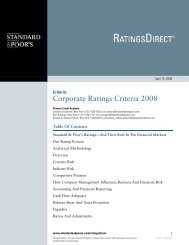European Infrastructure Finance Yearbook - Investing In Bonds ...
European Infrastructure Finance Yearbook - Investing In Bonds ...
European Infrastructure Finance Yearbook - Investing In Bonds ...
You also want an ePaper? Increase the reach of your titles
YUMPU automatically turns print PDFs into web optimized ePapers that Google loves.
PROJECT FINANCE/PUBLIC-PRIVATE PARTNERSHIPS<br />
Publication Date:<br />
Sept. 12, 2007<br />
Primary Credit Analyst:<br />
Lidia Polakovic,<br />
London,<br />
(44) 20-7176-3985<br />
Parvathy Iyer,<br />
Melbourne,<br />
(61) 3-9631-2034<br />
Secondary Credit Analysts:<br />
Arthur F Simonson,<br />
New York,<br />
(1) 212-438-2094<br />
Dick P Smith,<br />
New York,<br />
(1) 212-438-2095<br />
David Veno,<br />
New York,<br />
(1) 212-438-2108<br />
126 ■ NOVEMBER 2007<br />
STANDARD & POOR’S METHODOLOGY FOR SETTING THE<br />
CAPITAL CHARGE ON PROJECT FINANCE TRANSACTIONS<br />
<strong>In</strong> recent years, project debt issuers worldwide<br />
have increasingly been using financial<br />
guarantee insurance provided by monoline<br />
insurers, also referred to as monoline wraps. A<br />
key element in the process of the monoline wrap<br />
is the capital charge Standard & Poor’s assigns.<br />
This capital charge is important for determining<br />
the capital adequacy of, and ultimately the rating<br />
on, the monoline insurers. This article aims to<br />
make transparent the way Standard & Poor’s<br />
determines each project’s capital charge and<br />
supersedes the capital charges listed in our Global<br />
Bond <strong>In</strong>surance criteria book, which are no longer<br />
valid for project finance transactions.<br />
A monoline wrap provides an “unconditional<br />
and irrevocable” financial guarantee from the<br />
insurer to pay all or a certain portion of a<br />
project’s scheduled principal and interest on time<br />
and in full to debt providers if the project is<br />
unable to do so. The project debt guaranteed by<br />
the monoline is assigned a higher rating than the<br />
project’s underlying rating. This higher rating is<br />
equalized with the financial strength rating on the<br />
monoline. The underlying project debt rating,<br />
which Standard & Poor’s assigns to each wrapped<br />
project, is generally lower, reflecting the project’s<br />
real underlying business and financial risks. As a<br />
result of providing the guarantee, monolines are<br />
exposed to the underlying risk of the project.<br />
This determines their portfolio risk and the charge<br />
to capital.<br />
Each project finance transaction is unique, both<br />
in terms of risks and structural features, and so is<br />
the capital charge. Consequently, Standard &<br />
Poor’s uses the same methodology for every<br />
monoline insured project to calculate the<br />
applicable capital charge.<br />
Capital charges have been assigned by Standard<br />
& Poor’s since the mid 1980s but have been<br />
adjusted over time to reflect credit conditions and<br />
market trends.<br />
Defining The Capital Charge<br />
Capital charge is the theoretical loss based on a<br />
worst-case economic environment, i.e. an<br />
economic depression case. The capital charge is<br />
expressed as a product of:<br />
• Likelihood of default by the issuer (i.e.<br />
default risk or frequency); and<br />
• Severity of default measured in terms of loss<br />
in asset value recovery.<br />
STANDARD & POOR’S EUROPEAN INFRASTRUCTURE FINANCE YEARBOOK<br />
The default risk is equivalent to Standard &<br />
Poor’s default probability at a given rating. It does<br />
not vary between different projects that have been<br />
assigned the same rating. The severity factor is<br />
transaction specific, however, because each project<br />
has a unique combination of asset-related risks<br />
and contractual, financing, and legal issues.<br />
Consequently, the capital charge varies across<br />
asset classes and primarily reflects differences in<br />
the recovery potential.<br />
Once the two factors have been determined,<br />
the capital charge for issues is a percentage of<br />
par value.<br />
Standard & Poor’s applies the same capital<br />
charge across an entire rating category. Issues<br />
rated ‘A’, ‘A+’, and ‘A-’, for example, have the<br />
same capital charge. Once a capital charge has<br />
been assigned, Standard & Poor’s reviews it<br />
regularly as part of its surveillance.<br />
Furthermore, the same capital charge is used for<br />
all the insurers involved in that project,<br />
irrespective of which insurer provides the wrap.<br />
This is because the transaction default frequency<br />
and severity measure reflect the project risks and<br />
are independent of the insurance company that<br />
insures the project debt.<br />
The process of estimating capital charges can be<br />
complex and involve reasoning and modeling.<br />
Empirical data on new asset classes or new<br />
financing types, for example, is not always<br />
available or useful. Estimating loss-given default<br />
can also be complex in countries where the<br />
creditor regime has not been tested or the<br />
enforcement of security is complex and lengthy.<br />
The fundamental approach to calculating the<br />
capital charge for project debt is generally the<br />
same as that adopted for corporates.<br />
Nevertheless, the financing and structural aspects<br />
of a project can demand subjective judgment of<br />
recovery potential, and therefore the capital<br />
charge. Even so, similar transactions under a<br />
similar creditor regime are often likely to provide<br />
a good benchmark for a new transaction.<br />
Prerequisites<br />
Assigning an underlying rating to the project is a<br />
required step toward enabling the calculation of<br />
the capital charge. The underlying rating is<br />
determined in the same way as an unwrapped<br />
project debt rating and is based on the same<br />
criteria. The underlying rating is determined



